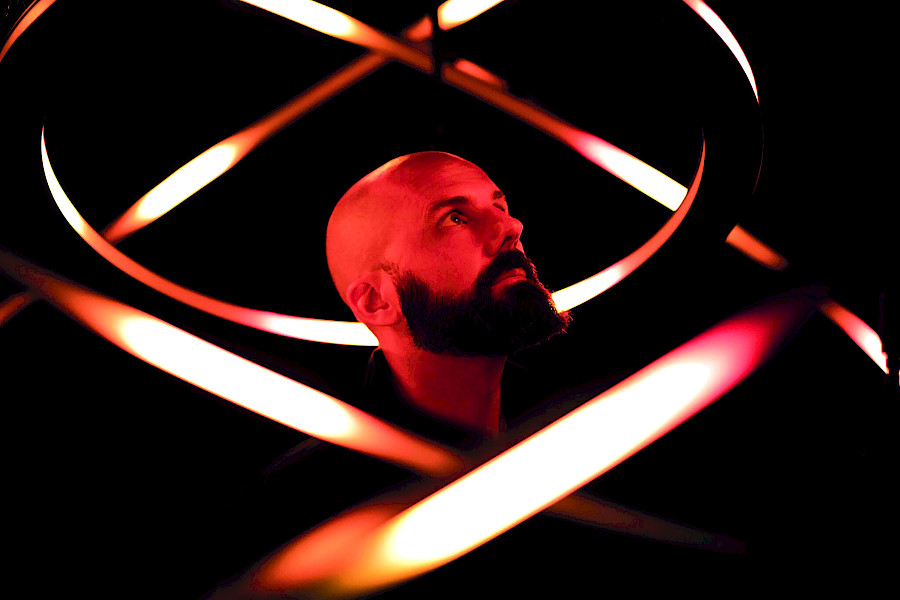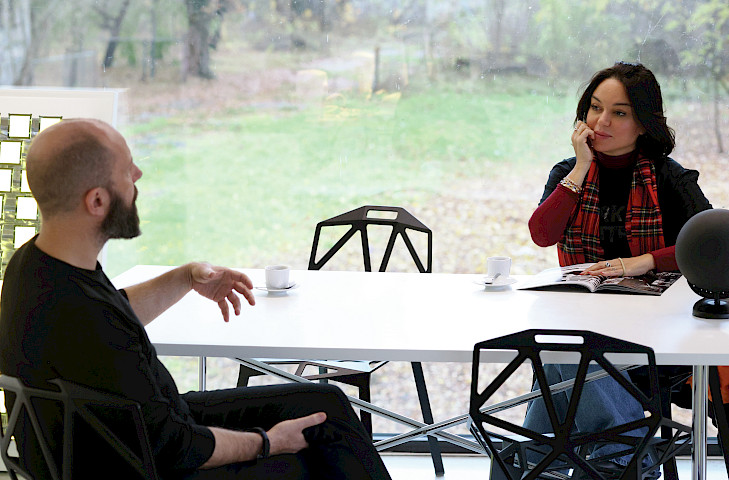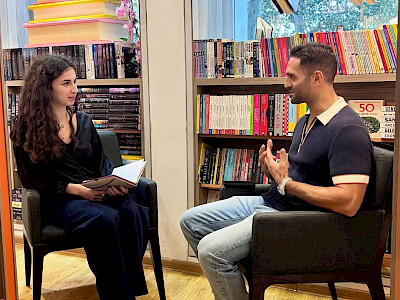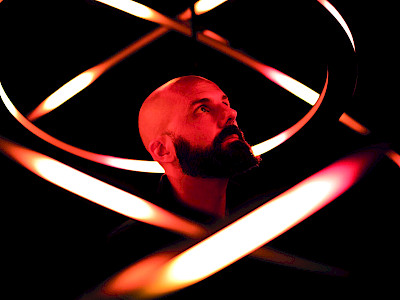
Christopher Bauder is a German light and media artist. He focuses on large-scale art installations around the world. His work involves sound, light, movement, and objects. Christopher has won several awards for his talent, including the German Lighting Award and the Red Dot Design Award. Ulviyya Mahmud travelled all the way to Berlin to meet him and to acknowledge the power of light.

INTERVIEW ULVIYYA MAHMUD
PHOTO OLIVIER RIMBON FOELLER, RALPH LARMANN, VLADISLAV MAKAROV

I work with light, and it only works in the darkness
What do you need to make shows like this?
I need a big location and money. The location size should be at least 40 by 20 metres with a height of 10 metres. That’s the minimum size, but the bigger the better. I also like industrial locations, but it doesn’t have to be industrial. It also needs to be completely dark, like pitch black dark.
Why dark?
Because I work with light, and it only works in the darkness.
What is your hidden message in your works?
Darkness deprives you of all the usual senses you rely on during the day. In the dark, everything is reduced – and that’s when I can charge you with something new. When you enter DARK MATTER, you come into another world; you can reach a kind of meditative state if you take the time to get into the rhythm of the installations. And that’s the idea. It’s the same with my large-scale shows: they’re pitch black. A dark, vast space makes you feel like you’re in a church. Regardless of one’s religious background, everybody has a certain feeling in a church.
Do you see dark black as something negative or positive?
I really like the darkness. I see it as totally positive. I love the night. I’m totally a creature of the night. For me, it’s something warm, almost like the feeling you had before you were born.
Do you make music?
Yes, I do. I create my own music. I don’t mix with other people’s music.
What comes first: the light or the music?
They actually come together – it’s like ping-pong. First comes the story – I start by sketching it out, making little drawings, creating a sort of storyboard. Then Chris composes little pieces of music for each part of the story, and we see how they fit together.
Are you always happy with your work?
If it’s finished, I’m happy. That’s why I do it, just because I want to do it.
How many people are on your team?
At the moment, we have 65 people in total, plus some freelancers. I also work with the freelancers who handle installations, since we tour around the world.
You came from a family of engineers – did that influence you in any way?
Yeah, that’s a funny thing. All my relatives, my dad, my grandfather, they’re all engineers. However, I didn’t study engineering. I studied art, but I think I might be the best engineer of all of them, because that’s what I do all the time. All the motor systems you see here are my creations. I develop all these motor systems, lights – everything. My work is creative at its core, but there’s a strong engineering element in everything I do.
Do you sell your lights?
Yes, I do. It isn’t only a piece of art but also a product. It’s kind of cross-pollinating between these two things. I do the art piece first, and then the client comes along. For instance, I didn’t know that Mercedes had launched a car or something. They saw my light show and asked something similar for a car launch, so we collaborated. The story with ABBA is the same; they saw my show, and they asked me to work with them. So, it always goes in both directions. Since my art is so expensive, as an artist, I could never afford to do this; that’s why I balance the commercial projects and the art. I don’t believe in separating art from commerce. Art is commercial. People make their art to sell it to someone to collect, or they charge for tickets. Even at Tate Modern, for example, last year the sponsor was Hyundai.
Did you work with any musicals?
No, but we work in everything – from theatres to big tours. We tour worldwide with some A-listers. We also create installations for the clubs and many other types of venues.
Have you worked with any clubs in Berlin?
Not really. In Berlin, they’re not interested in this fancy stuff. Berlin club culture is all about the dancing, not the lights. But, for instance, we worked at Hakkasan Nightclub in Las Vegas back in 2019. Still, the clubs in Berlin are a piece of art. I always say that my inspiration is the techno culture of Berlin. I grew up here in the late 90s – that’s my driving force.
What I like about Berlin is that it’s not about promotion. What do you think?
Berlin is super honest. It can be both good and bad. Berliners are incredibly picky – if they like something, that’s great, but if not, they’ll make it clear. What works elsewhere might not work in Berlin.
What is more important to you: creating for yourself or for people?
I create because I enjoy it. In the DARK MATTER, I didn’t create for people to say, “this is the most attractive” or anything like that. This is just the installation I like to do. And I’m glad that people like it and come. But I would never create anything to please someone.
Your work is like a combination of technology and sensitivity. How do you come up with these ideas?
My inspiration usually comes from two directions. One is technology – I’m fascinated by innovation and creating things that weren’t possible before. The other is storytelling – thinking about what kind of story I want to tell through my work.
What do you want to tell through your work?
I want to discuss different stories – it depends. For example, one show I did was about communication – from human communication to machines, networks, and the Internet. It was about how we connect with each other. Another show was focused on emotions, where each section showed different feelings – love, anger, hate, and so on. And my Christmas show isn’t exactly about Christmas itself; it’s more about the atmosphere – the anticipation, the fascination, that longing for the magical world of Christmas.
Who is the most artistic in your family?
My mom. She paints, sculpts, and has always been drawn to art. She mainly worked in fashion, though she never got to fully realise her dream because she became a housewife. She didn’t get to follow her artistic spirit as a career – so in a way, I’m doing that for her now. And my dad’s side is more focused on engineering.
What’s the brightest memory of your childhood?
I like my childhood. I’m still kind of a kid. I never lost that connection. My happiest memories of childhood are all about nature. I used to spend hours outdoors. I’d go straight to the forest after school and stay there until it got completely dark.
In the DARK MATTER exhibition, there is a Bonfire installation with people sitting there and watching it. I spent almost an hour there before realising I could just look at a real fireplace at home – yet somehow, it didn’t feel the same. Why do you think that is?
It’s the perfection of fire. You can never have such a perfect fire in real life. You might have an image of it in your mind, or see it in films, but when you try to make one yourself, something always goes wrong. The wood is damp, or it doesn’t burn quite right, or you run out of fuel. And those perfect “sitting by the fire with a guitar” moments only really happen in movies. With this installation, it’s the perfection and repeatability of the experience. It’s always there – you don’t have to light it; you don’t have to maintain it. It’s effortless. I like this idea of imitating nature, and how even the imitation can hold the same kind of fascination as the real thing.
And I actually started to feel warm…
Yes! That is the funny thing. In the beginning, I wanted to put hot air blowers inside to make it feel real. But then I realised people already felt warmer just by being there. Of course, the temperature in the room doesn’t actually change — but I trigger your own memories. That’s the idea. I use very abstract means to evoke very concrete sensations and memories that already exist within you.
But how do you do that?
How? I don’t know. It’s intuitive. I work purely by intuition. I don’t have a plan; I don’t do research. I’m not like other artists. Many artists paint something, then come back, unsatisfied, and change it again. I never do that. When I say it’s finished, it’s done. Even if I look at my work later and think, “I could add a bit more detail here,” it doesn’t matter. It wouldn’t make it even one per cent better, and the audience wouldn’t notice anyway.

Never create anything to please someone
- Bauder comes from an engineering family and has always been interested in technology.
- The works in Dark Matter are from the last 20 years, so it is a kind of Bauder archive.
- Bauder is a light artist, designer, inventor, and musician all in one.
- With his shows, Bauder pushes beyond the audiovisual.
- Bauder comes from a Berlin background, as a Berlin underground party kid.




